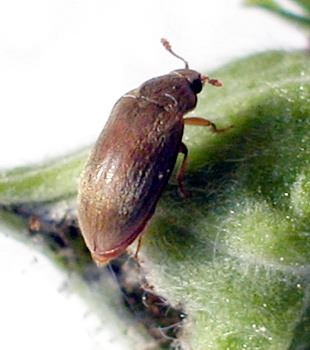Pests
Byturus tomentosus (De Geer) - Raspberry Beetle.
Systematic position.
Class Insecta, order Coleoptera, family Byturidae, genus Byturus.Synonyms.
Trixagus tomentosus F., T. sambuci Seidl.Biological group.
Pest of fruit and berry cultures.Morphology and biology.
Beetle is elongate oval, grayish-black, covered with dense rusty-yellow or gray hairs giving various tints to body. Antenna 11-segmented, clavate. Body length 3.8-4.3 mm. Eggs elongate-elliptic, white or yellowish, about 1 mm long. Larva vermicular, with three pairs of small thoracic legs. Its body light brown or yellowish, covered with sparse light hairs, with brown transverse spots on each segment dorsally, and with two hooked upward spines on the ninth segment. Larval head well visible, dark-colored. Length 6-6.5 mm. Pupa white, 3.5-4.0 mm in length. Female lays eggs by one in flowers between stamens and pistils and on ovary tops; 20-30 eggs in all. Larva hatches in 8-10 days, some time lives openly outside a fruit, and then gnaws it, eating fleshy receptacle and adjoining part of drupelets. Its development in a raspberry fruit lasts about 1.5 months, grasping the period of fruit maturing; therefore, the larvae frequently meet in the gathered berries. During berry maturing, the larvae leave it and go in the ground, where they pupate in cradles at depth of 5-20 cm. Immature beetles and larvae winter in the ground.Distribution.
The species inhabits Europe, Turkey, Afghanistan, Nepal, Bhutan, China, Japan; it has been recorded in California. In the former USSR, it is widely distributed in the European part, in the Caucasus, in southeastern and eastern parts of Kazakhstan, in Siberia and the Far East.Ecology.
Generation is one year, partly biennial. In spring, the beetles appear on a surface at the end of April or in the first half of May at temperature of the top soil layer 12-13°C which coincides with the period of flowering of fruiters and bird cherries. At first, the beetles feed on various cultural and wild plants (currant, gooseberry, apple, cherry, pear, plum, etc.), eating nectar and anthers of flowers; then they fly on raspberry plantings. The flight distance reaches 120 m. The beetles populate raspberry sometimes even before occurrence of buds. The period of additional feeding lasts about 2 weeks. The feeding by pollen of additional host plants accelerates maturing of sexual products in females by almost 2 times in comparison with the beetles constantly eating raspberry leaves and buds. Oviposition coincides with the period of mass flowering of raspberry. Finishing development, some larvae diapause and winter, pupating in August of the next year. The amount of diapausing larvae changes by years from 10 to 82% relating to number of all wintering individuals. The later the larvae hatch and finish feeding, the greater number of larvae wintering. Depth and place of their wintering depend basically on soil structure and humidity. Beetles of new generation appear in the second half of August or in the first half of September.Economic significance.
The pest damages cultural and wild growing raspberry, and also blackberry. Beetles meet on cloudberry, stone berry, apple, cherry, pear, plum, mountain ash, and other fruit and berry cultures, and also on bird cherry. Imagoes feed on flowers, eating away nectaries (lepals); larvae develop in flowers and fruits. During additional feeding on raspberry, the beetles eat young leaflets, gnawing out narrow oblong apertures between veins. After occurrence of buds and flowers, they eat them, gnawing out buds or eating away nectaries and less often other parts of flowers, not touching sepals. The berries developing from partly damaged flowers have ugly form; those damaged by larvae become small, become dim in color, fade or rot. The species has the greatest significance in northern and middle areas of the former USSR, harming especially strongly during humid years. Control measures: Agronomical ones are digging-over the soil around bushes and inter-row plowing where the beetles, larvae and pupae winter. Chemical measures are application of chemical preparations during red buds and balloon.s status growth stages in order to prevent oviposition. White sticky traps have been recommended to catch beetles.Reference citations.
Babenko Z.S. 1982. Phytophagous insects of fruit and berry plants in forest zone of Ob River Region. Tomsk: Tomsk University, 268 p. (in Russian).Gur.eva E.L. 1974. Family Byturidae. In: Kryzhanovskii, O.L., ed. Insects and mites . pests of agricultural plants. V. 2. Coleoptera. Leningrad: Nauka, p. 112-113 (in Russian).
Savkovskii P.P. 1976. Atlas of the pests of fruit and berry plants. Kiev: Urozhai. 207 p. (in Russian).
Savzdarg E.E. 1960. Pests of berry cultures. Moscow: Sel.khozgiz, 270 p. (in Russian).


